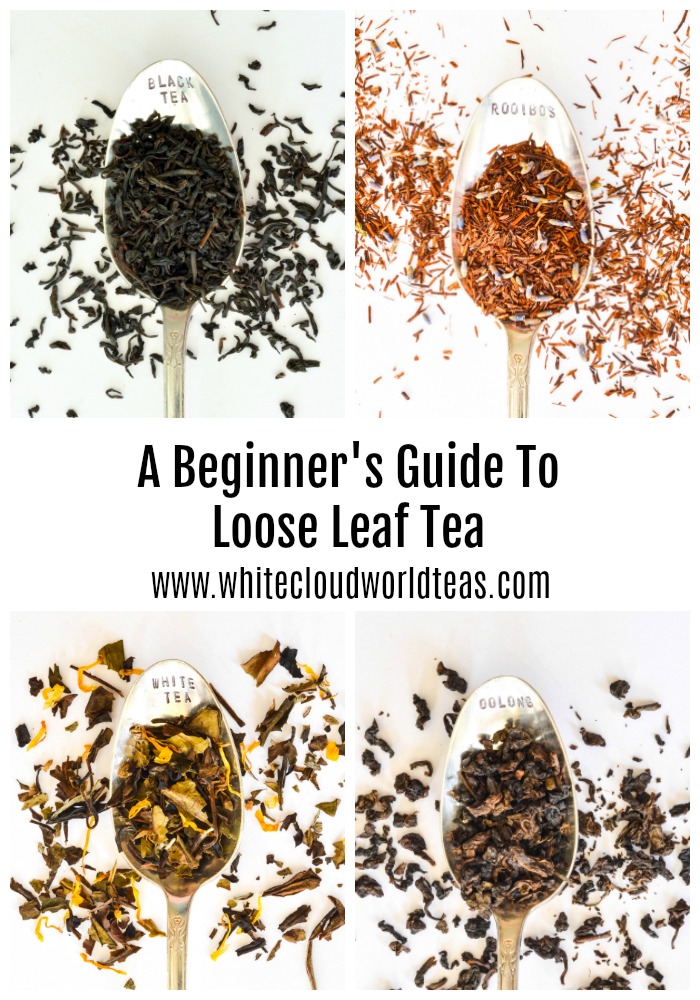A Beginner's Guide to Loose Leaf Tea Varieties
Posted by Heather Haan on 15th Feb 2019
Whether you are a seasoned tea drinker or new to sipping this cozy beverage; this beginner's guide to loose leaf tea varieties will help you pick the perfect tea for your next cup!

All tea comes from the leaves of the same plant, the camellia sinensis, an evergreen shrub that is native to India and China, which can grow up to 18 meters in the wild. Today, due to the popularity of tea, camellia sinensis is grown worldwide to meet the demands of tea drinkers. The region where the tea is grown, the soil and climate conditions, as well as how the tea is processed and oxidized (also known as fermented), all affect the final flavor and characteristics of the tea.
Any "teas" that are made from other plants, herbs, grains or flowers are actually not "teas" but are considered herbal infusions, even if they have tea in their name.
Here at White Cloud World Teas, we offer a wide variety of loose leaf teas and herbal infusions that can be enjoyed hot or brewed for iced tea. Loose leaf tea, as opposed to tea in tea bags, is the freshest and most flavorful form of tea. Below you can read a little bit more about each variety of tea and can click on each variety at the top of this page (or below) to purchase.
A Beginner's Guide to Loose Leaf Tea Varieties:

Black Tea – Black tea is the most popular tea variety consumed in western cultures. It is withered, fully oxidized and dried. Black tea yields an amber or chocolate colored brew, has a strong flavor and has more caffeine than other tea varieties. Some black tea varieties include English Breakfast Tea, Earl Grey and Darjeeling.

Oolong Tea – Oolong tea is a traditional Chinese tea and is very popular in China, Taiwan and Japan. Oolong tea is withered, partially oxidized and dried. It is a cross between black and green tea in color and taste, and it can have bold flavor profiles that are woody, smoky, sweet and fruity.

Green Tea – Green tea skips the oxidizing step and is
simply withered and then dried and sometimes roasted. It has a more delicate
taste, with sweet, grassy and fruity tasting profiles; and it is pale green or golden yellow in color. Green tea is known for its health benefits and high concentration of antioxidants.

Matcha Tea – Matcha, a powdered green tea typically used in Japanese tea ceremonies, has become quite popular in recent years for not only drinking, but cooking and baking too. Not only is Matcha great for a boost of energy and known for reducing stress, matcha is packed with antioxidants, called polyphenols, which have been shown to have anti-aging benefits, as well as help protect against heart disease and cancer.

White Tea – White tea is a rare tea from China and is the least processed of all the teas. It is not oxidized or rolled, but simply withered and dried by steaming. Because of this, white tea has the highest levels of antioxidants. White tea is very light is color and has a delicate taste with little bitterness.
A Guide To Herbal Teas And Infusions:

Rooibos Tea – Rooibos tea, also known as red tea, is a caffeine free herbal tea made from the Aspalathus Linearisplant, a shrub native to South Africa. Rooibos tea is known for its antioxidant-rich health benefits. It has a unique flavor profile and can taste earthy, nutty, spicy, sweet and fruity.

Yerba Mate Tea –Yerba Mate Tea is made from the leaves and twigs of the Ilex paraguariensis plant, a species of the holly tree. It is very popular in South American countries and has a strong, distinct taste. Yerba Mate tea is known for being a natural energy booster and can sometimes be found in energy drinks and supplements.

Herbal Infusions – Herbal tea infusions are made from herbs, flowers, grasses and spices; things like cinnamon bark, lemon peel, lemon grass, mint and flowers such as chamomile, rose and hibiscus. These natural ingredients are dried, packaged and steeped like tea, but since they do not come from the camellia sinensis bush, they are not considered tea.
For more information about tea varieties, click here, and check out these other helpful articles:
A Guide to Matcha Tea {Plus 10 Matcha Tea Recipes}
How To Make Loose Leaf Iced Tea {Plus 10 Flavorful Iced Tea Recipes}
10 Hot Tea Recipes to Warm You Up This Fall
This article, A Beginner's Guide to Loose Leaf Tea Varieties, was written by Heather Haan of Kitchen Concoctions. Heather has spent most of her life developing and concocting recipes inspired by the rich southern traditions and flavors she grew up with. She is passionate about food, travel and cooking and enjoys sharing this passion; as well as stories about life in Texas, on her blog Kitchen Concoctions. You can also find Heather online on Facebook,Twitter, Instagram and Pinterest.
